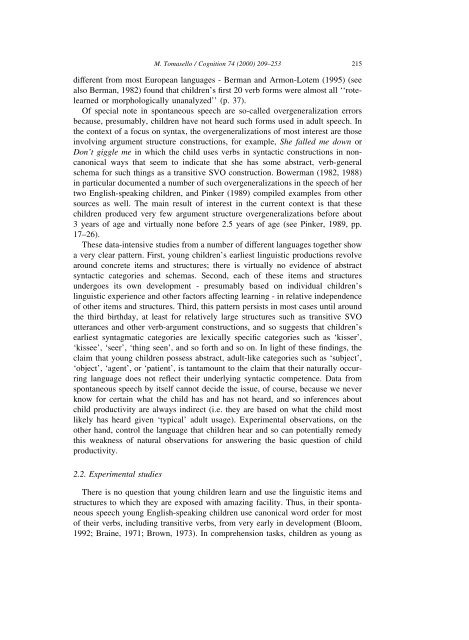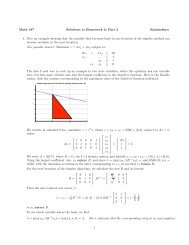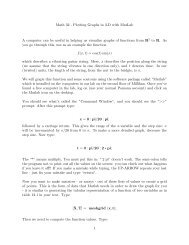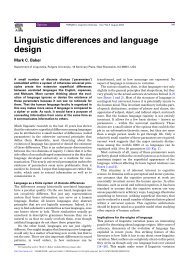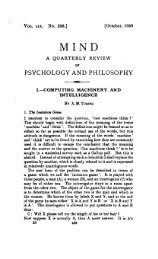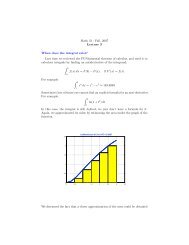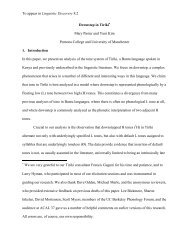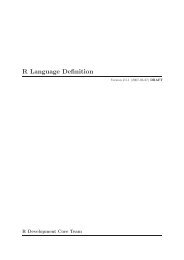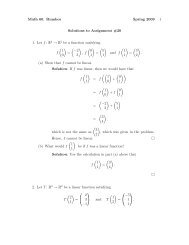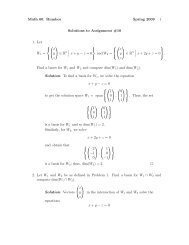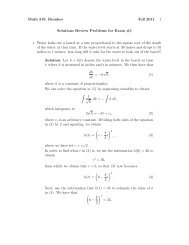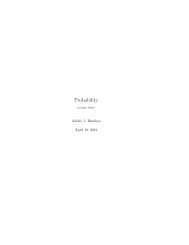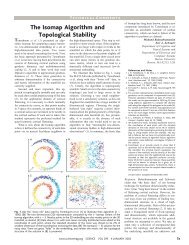Tomasello
Tomasello
Tomasello
You also want an ePaper? Increase the reach of your titles
YUMPU automatically turns print PDFs into web optimized ePapers that Google loves.
different from most European languages - Berman and Armon-Lotem (1995) (seealso Berman, 1982) found that children's ®rst 20 verb forms were almost all ``rotelearnedor morphologically unanalyzed'' (p. 37).Of special note in spontaneous speech are so-called overgeneralization errorsbecause, presumably, children have not heard such forms used in adult speech. Inthe context of a focus on syntax, the overgeneralizations of most interest are thoseinvolving argument structure constructions, for example, She falled me down orDon't giggle me in which the child uses verbs in syntactic constructions in noncanonicalways that seem to indicate that she has some abstract, verb-generalschema for such things as a transitive SVO construction. Bowerman (1982, 1988)in particular documented a number of such overgeneralizations in the speech of hertwo English-speaking children, and Pinker (1989) compiled examples from othersources as well. The main result of interest in the current context is that thesechildren produced very few argument structure overgeneralizations before about3 years of age and virtually none before 2.5 years of age (see Pinker, 1989, pp.17±26).These data-intensive studies from a number of different languages together showa very clear pattern. First, young children's earliest linguistic productions revolvearound concrete items and structures; there is virtually no evidence of abstractsyntactic categories and schemas. Second, each of these items and structuresundergoes its own development - presumably based on individual children'slinguistic experience and other factors affecting learning - in relative independenceof other items and structures. Third, this pattern persists in most cases until aroundthe third birthday, at least for relatively large structures such as transitive SVOutterances and other verb-argument constructions, and so suggests that children'searliest syntagmatic categories are lexically speci®c categories such as `kisser',`kissee', `seer', `thing seen', and so forth and so on. In light of these ®ndings, theclaim that young children possess abstract, adult-like categories such as `subject',`object', `agent', or `patient', is tantamount to the claim that their naturally occurringlanguage does not re¯ect their underlying syntactic competence. Data fromspontaneous speech by itself cannot decide the issue, of course, because we neverknow for certain what the child has and has not heard, and so inferences aboutchild productivity are always indirect (i.e. they are based on what the child mostlikely has heard given `typical' adult usage). Experimental observations, on theother hand, control the language that children hear and so can potentially remedythis weakness of natural observations for answering the basic question of childproductivity.2.2. Experimental studiesM. <strong>Tomasello</strong> / Cognition 74 (2000) 209±253 215There is no question that young children learn and use the linguistic items andstructures to which they are exposed with amazing facility. Thus, in their spontaneousspeech young English-speaking children use canonical word order for mostof their verbs, including transitive verbs, from very early in development (Bloom,1992; Braine, 1971; Brown, 1973). In comprehension tasks, children as young as


